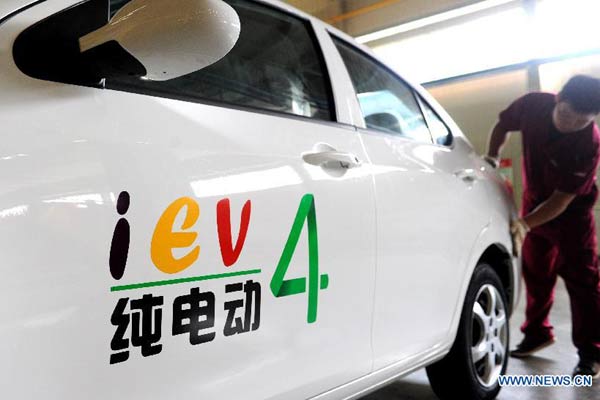
Electric cars seem to be an ideal option among next-generation automobiles: They are eco-friendly and accelerate fast with less noise, among other benefits.
The trouble is that every 300 kilometers you may have to wait hours to refill your batteries at a charging station.
Now, researchers from China and the United States have come up with a possible solution. On Friday, a research result published in the journal Science reported a method that promises to triple the energy capacity of supercapacitors, making them comparable - and perhaps superior - to some advanced batteries.
"We have managed to find a balance between fast-charging and storage capacity that could make supercapacitors available for practical applications," said Lin Tianquan, a member of the research team from the Shanghai Institute of Ceramics affiliated with the Chinese Academy of Sciences.
Lithium-ion batteries, like those used in mobile phones and electric cars, are characterized by high capacity compared with their volume and weight. But the disadvantage is obvious, too: they usually take a long time to charge and have limited peak power because the risk of overheating.
Supercapacitors are a different type of energy storage device. Usually, supercapacitors have superfast recharging times and higher limits on output power, but the storage capacity is only 5 percent of that of lithium-ion batteries.
Researchers at the Shanghai Institute of Ceramics, Peking University and the University of Pennsylvania improved a material called grapheme to increase the storage of supercapacitors while keeping their other good features.
"We managed to enhance the properties of supercapacitors by changing the structure of graphene," said Huang Fuqiang, a researcher at the Shanghai Institute of Ceramics.
Graphene is one of the thinnest, lightest, strongest and most conductive materials known to man. It consists of a single layer of carbon atoms arranged in a honeycomb structure. The scientists changed the structure into tubes 4 to 6 nanometers wide. The tubes allow an increase storage capacity.
Before the improvement, a bus could recharge for 30 seconds and run for 5 kilometers on a traditional supercapacitor.
"That works in a small city or airport, but there is obviously a lot to be desired," I-Wei Chen, a materials physicist at the University of Pennsylvania who also worked on the breakthrough, was quoted as saying by IEEE Spectrum, a magazine of the Institute of Electrical and Electronics Engineers in the US.
"Our battery has five times the energy, so it can run 25 kilometers and still charge at the same speed. We are then talking about serious applications in a serious way in transportation," he said. (China Daily)

A worker checks a pure electric car at a workshop in Jianghuai Automobile Co Ltd in Hefei, capital of East China's Anhui province, Aug 19, 2014. [Photo/Xinhua]

86-10-68597521 (day)
86-10-68597289 (night)

52 Sanlihe Rd., Xicheng District,
Beijing, China (100864)

